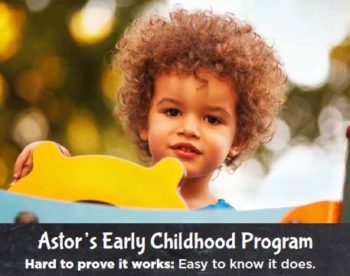
by Virginia Hayes Sibbison, Ph.D.
To properly prove the impact of getting into the heads and hearts of children, you would have to follow them through their school careers. More easily said than done.
To know the programs work, you only have to watch the kids, talk to their parents and read the reports of kindergarten teachers.
Astor’s Early Head Start Program (EHS) is unquestionably an intervention that gives kids the tools they will need as they head into life. There is a great deal of sound science in the field of education. The impact of early childhood education efforts has been studied, evaluated and reported by authorities such as Nobel Prizewinner Dr. James J. Heckman, Professor of Economics, The University of Chicago.
His research and that of others found that early childhood education from birth through age five is an essential and effective investment. It is an investment, not just in the immediate emotional, intellectual, educational and emotional growth of children, but also into their long-term future successes.
The Astor EHS Program provides services to children aged birth to 36 months, including those with special needs. During the ages of 18 to 36 months, the youngsters are considered “seniors” whose activities are geared for their transition tothe Astor Head Start Program for 3-5 year olds.
According to Mary Sontheimer, assistant executive director, education and early childhood development programs, “Astor is deeply committed to ensuring that each child is given the best experiences to build a solid foundation for his or her future.”
Virtually all of the parents in the program are poor. They include the documented and undocumented, as well as those who come from Child Protective Services, shelters and public housing. Many families have significant health issues and suffer from crime,poverty, and high dropout rates. Pregnant mothers are included.
Parents are provided with “positive experiences”in the classrooms and during home visits. They join policy groups and advisory committees and participate in free breakfast and lunch programs. Aided by a nutritionist, parents help in food selection and preparation for themselves and their children.
The Early Head Start classroom staff and the Parent Infant Educators (PIEs) guide parents to resources such as parenting classes and referrals to community services. They make home visits. Sontheimer stresses that there is much more involved than just the joy of interacting with kids and parents that give the staff energy and commitment.
The federal government funds the programs and money is always tight. There is an ever-present need to be creative in order to make the programs stay alive and fresh. It is hard work. The list of regulating and supervising agencies is long.
Astor’s own commitment to high quality services is at the forefront.
For Mary Sontheimer and the dedicated Astor staff, nothing beats the experience of working with these precious kids and their parents. In the big world, with education important to many parents, it is easy for people to forget how much they can contribute to the lives of these challenged families.
Readers, rightfully dedicated to their own families, should think and act. If this is what I want for my children, it should be what I want for all children.
Those interested in learning more about the Astor Early Head Start Program, including opportunities for contributions and volunteer participation, should contact Kim Fragetta, Head Start Director (845) 452-4167.

